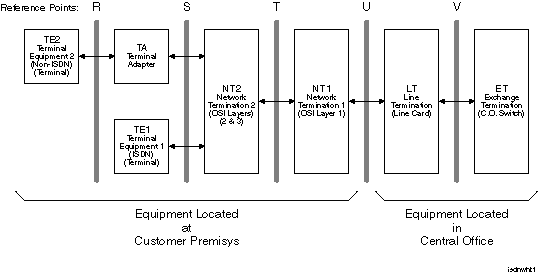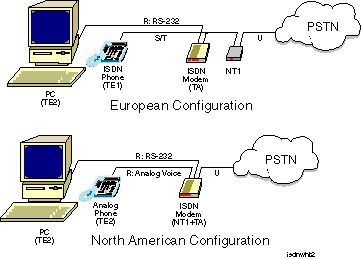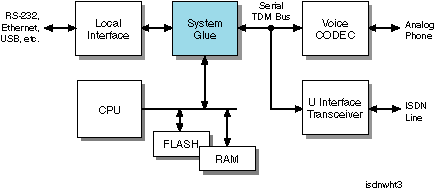
 |
|
Xilinx at Work in ISDN Modems -
|
|
|
|
IntroductionThis white paper gives an overview of ISDN modem technologies and how Xilinx high volume programmable devices can be used to implement complex system level glue in ISDN modem designs. The Xilinx device families targeted at these high volume applications include XC9500 CPLDs and Spartan FPGAs.The flow of this document will be start with an overview of ISDN technology and how ISDN modems are used. We will next examine the major functional blocks of an ISDN modem and give an overview of the Application Specific Standard Products (ASSPs) that implement ISDN functions. We will then illustrate the system level glue functions that are needed by way of a design example. OverviewISDN (Integrated Services Digital Network) is a technology that was originally defined in the mid-80s as a means of delivering integrated voice, data, and video services to Bell system customers. Although the technology definitely shows its age, it is still one of the most widely deployed digital data services.ISDN is a circuit switched technology. In circuit switching, a dedicated communications path is established between two stations. The process of establishing these dedicated paths is referred to as signaling, and is carried out over special channels referred to as D (Delta) channels. Signaling results in the establishment of one or more 64 kilobit-per-second (kbps) B (Bearer) channels between locations. Once established, these channels can be used for voice, data or video. There are two main ISDN variants, Basic Rate ISDN (BRI) and Primary Rate ISDN (PRI). Primary Rate ISDN service is targeted at larger corporate customers. PRI service consists of 23 B channels in North America and is transported across a standard T1 physical layer interface. In Europe the service provides 30 B channels plus one 64 kbps D channel and uses an E1 physical layer. PRI requires two sets of twisted pair telephone lines. Basic Rate ISDN services are targeted at home and small business users. BRI service is delivered over a single twisted pair, the same wiring that is used to deliver POTS (Plain Old Telephone Service). It provides 2 B channels and one 16 kbps D channel. For the rest of this paper the term ISDN will be used synonymously with Basic Rate ISDN. ISDN ModelThe CCITT documentation defines the overall model of ISDN in terms of Reference Points and Functional Groupings. Figure 1 illustrates the ISDN Reference Model. |

| Functional Groupings define finite arrangements of physical equipment
or combinations of equipment. ISDN defines the following Functional
Groupings:
TA (Terminal Adapter): Adapts non-ISDN equipment to ISDN. A TA provides an R interface for the non-ISDN equipment and an S/T interface for connection to the ISDN network. TE1 (Terminal Equipment 1): ISDN terminal equipment such as ISDN telephones. These devices interface to the ISDN network by way of an S interface. NT1 (Network Termination Equipment for layer 1): Equipment that terminates the ISDN network connection at OSI layer 1 (the physical layer). Specifically it terminates the U interface and converts it into an S/T interface. NT2 (Network Termination Equipment for layer 2): Equipment that terminates the ISDN network interface at OSI layer 2, (the data link layer). An example would be a PBX that terminates a PRI connection and provides several BRI interfaces. An NT2 interfaces to a TA or TE1 via an S interface and to an NT1 via a T interface. T: The interface between an NT1 and NT2. It is functionally equivalent to the S interface. U (User): The interface between the ISDN customer premises equipment and the public ISDN network. This interface defines a point to point connection using a single twisted pair and 2B1Q data coding. U InterfaceThe U (User) Interface is a point to point connection between subscribers and the service providerís central office. It consists of a single twisted pair that may be up to 5.5 km in length. Mid-span repeaters can double this distance.In order to support transmission over these distances the U Interface uses some sophisticated transmission technology. A multilevel, 2B1Q (Two Binary, One Quaternary) line code (4B3T in Europe) is used as well as adaptive equalization and echo cancellation. In addition a scrambling polynomial is used to improve clock recovery and improve the spectral characteristics of the signal on the wire. S/T InterfaceThe S/T Interface was defined for interconnecting ISDN customer premises equipment. As a result the technology employed differs significantly from that of the U Interface. The S/T Interface supports a bus topology with up to eight stations. Using four wires it supports a maximum distance of 1 km. The shorter distances involved, and full duplex transmission, simplify the line coding. An Alternate Space Inversion (ASI) coding scheme, also referred to as pseudo-ternary scheme, is used.Proprietary TDM InterfacesIn addition to the interfaces defined in the ISDN specifications, vendors of ISDN ASSPs have defined several proprietary interfaces for tying together ISDN devices in a system. A typical application for such an interface is connecting an S/T interface ASSP to a U interface ASSP to create an NT1. These interfaces typically consist of four to seven signals. These signals include a transmission clock, serial data in, serial data out, and a start of frame indicator.Several of the key TDM interfaces are as follows: IOM-2: ISDN Oriented Modular Interface, defined by Infineon (formerly Siemens) and supported by AMD as part of a second source relationship. IDL: Inter-chip Digital Link, defined by Motorola. ISDN in the Real WorldNow that we have had an overview of ISDN technology in the abstract, letís see how these technologies are packaged in the real world to create ISDN modems. Figure 2 illustrates how ISDN modems are typically deployed in Europe and North America. |

| In Europe the telephone companies do not let subscribers connect their
own equipment directly to the Public Switched Telephone Network (PSTN).
The Telco provides an NT1 to the customer as part of the service package.
In this case the demarcation point between the subscriber and the PSTN is
the S/T interface on the NT1, and the ISDN modem acts as a TA.
In North America, users can connect their own equipment directly to the PSTN and the demarcation point becomes the U interface. As a result, ISDN modems for the North American market typically include a built-in NT1. This lowers cost and simplifies installation. Another difference between the European and North American configurations is how voice services are provided. In Europe there was reasonable acceptance of ISDN telephones. If an ISDN telephone is used it is simply connected to the S/T interface along with the modem. In North America ISDN phones are very rare and as a result ISDN modems include the circuitry necessary to convert digital voice signals into the analog form used by a standard telephone. Anatomy of an ISDN ModemThe functional blocks that make up an ISDN modem are a function of whether the device is an add-in card for a personal computer or a stand-alone unit.An external modem, or active TA, includes a processor for protocol processing, logic for the R Interface, and usually a voice COder/DECoder (CODEC). The inclusion of a CODEC lets the user plug in a standard analog phone and use it to make voice calls over one of the ISDN B channels. The R interface is typically RS-232, Ethernet or USB and is implemented using an ASSP. Figure 3 shows a block diagram for an external modem. |

| The system glue has two functions within the architecture. The first
is to normalize interface differences between the functional blocks.
The second is to implement the required ISDN functional groupings.
In this application this means the TA functions required to support the
non-ISDN interfaces, specifically the R interface that embodies the local
side of the modem and the CODEC. TA functions that must be implemented
include Link Access Procedure D Channel (LAPD) framing functions that are
used in signaling and Point to Point Protocol (PPP) or Multilink PPP functions
that are used to transport data from the R interface across the ISDN network.
Internal modems, or Passive TAs, can eliminate hardware by moving functions to the host system. This reduces the system glue to providing interface glue functions for two interfaces: the host bus interface, and the serial TDM bus interface for the U-Interface transceiver. The TA functions included in the system glue are equivalent to those of the External modem. Figure 4 shows the block diagram for an internal modem. |

ISDN EnhancementsThe limited availability of DSL services has stimulated vendors to look for ways to provide DSL-like services using ISDN technology. While ISDN cannot compete with the bandwidth available from the newer DSL services, they have developed two approaches that give users the continuous availability that DSL provides.Always On ISDNThe first of these approaches is called Always On ISDN. It does this by using the D channel not just for signaling but also for forwarding Internet Protocol (IP) traffic using the X.25 protocol. Since the D channel is always connected this provides the subscriber with up to 16 kbps of continuously available bandwidth. When the user traffic exceeds the bandwidth of the D channel, one or both of the B channels are connected.Taking advantage of this requires that Always On support be provided by the userís Internet Service Provider (ISP), Phone Company, and the ISDN bridge or router that is used. IDSLA second approach to DSL-like ISDN service is IDSL. Originally developed by AscendIDSL uses U Interface transmission technology to provide 144 kbps of bandwidth by way of the two B and one D channels. The channels are all continuously connected and therefore the ISDN signaling mechanisms are not used. All traffic is routed to the subscriberís ISP. One downside to IDSL is that it does not support the ability to place circuit switched calls for voice or video conferencing applications. If the subscriber wishes to use the connection for voice traffic, a packet based voice technology such as Voice Over IP (VOIP) could be used. ISDN ASSPsThe following table summarizes the ISDN ASSP offerings of several vendors. |
| Supplier | Device | Function |
| Motorola |
MC145572 | U-Interface Transceiver |
| MC145574 | S/T-Interface Transceiver | |
| MC145575 | Passive ISDN Terminal Adapter | |
| MC145576 | Single-Chip NT1 | |
| AMD |
Am79C30A/32A | Digital Subscriber Controller |
| Lucent |
T7234 | Single-Chip NT1 |
| T7256 | Single-Chip NT1 with Microprocessor and TDM Interface | |
| T7237 | U-Interface 2B1Q Transceiver | |
| T9000/T9001 | ISDN Network Termination Node (NTN) Devices | |
| T7250 | S/T-Interface with HDLC | |
| National |
TP3410 | U-Interface Transceiver |
| TP3420A | S/T Interface Device | |
| Infineon |
PEB 2091 | U-Interface Transceiver |
| PEB 2086 | S/T Interface Device | |
| PEB 8090 | Single-Chip NT1 | |
| PEB 8191 | Single-Chip NT1 with Microprocessor and TDM Interface | |
| Yamaha |
YTD423 | HDLC with Microprocessor Interface |
| YTD421 | S/T Interface Device | |
| AKM |
AK520S | Single-Chip NT1 |
| Most of these products fall into one of the following categories:
S/T Interface Transceiver: Includes the S/T interface logic and an interface to a TDM bus at the back end. Single chip NT1: An S/T Interface Transceiver and a U Interface Transceiver connected back to back. Terminal Adapter: These devices implement the LAPD and PPP framing functions that were previously mentioned and often include a host bus interface. Design Example: An ISDN PCMCIA ModemIn order to illustrate how Spartan devices can be used to implement the system glue functions required to implement an ISDN modem, Xilinx has created an application note describing the architecture of a Spartan device based PCMCIA ISDN modem.A key design objective for this application was the creation of a solution with the lowest possible cost. In this case the target was a semiconductor bill of materials for the PCMCIA interface that is significantly less than $20 in volume. A second objective was to simplify the design effort by utilizing as much commercially available Intellectual Property (IP) as possible. Figure 5 gives an overview of the design. It consists of an ISDN U-Interface transceiver, the Spartan device, and external memory. The device that was chosen for the ISDN U-Interface in this application is a Motorola MC145572. The U-Interface connects to the rest of the design by way of two interfaces. The IDL interface is a five-wire TDM interface, defined by Motorola, and carries the B and D channel data. The PCP interface is an eight-bit microprocessor bus interface used to access the internal control and status registers of the U-Interface transceiver. |

Three external memory devices are connected to the Spartan device. A serial configuration PROM is used for device initialization. A 2Kx8 EEPROM is used to store the PCMCIA CIS data structure. An 8Kx8 SRAM provides buffering for incoming and outgoing ISDN traffic. ConclusionUntil digital modem ASSP manufacturers deliver more highly integrated solutions, designers of these products will be faced with the task of interfacing a variety of devices with incompatible interfaces. Xilinx high volume FPGA and CPLD technologies provide system designers with cost effective solutions that retain the traditional PLD time to market advantage.ReferencesMC145572 ISDN U-Interface Transceiver Manual, Motorola |